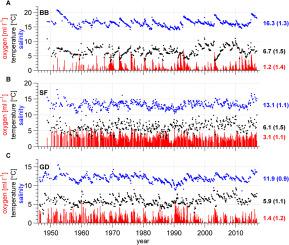当前位置:
X-MOL 学术
›
J. Mar. Syst.
›
论文详情
Our official English website, www.x-mol.net, welcomes your feedback! (Note: you will need to create a separate account there.)
Long-term variability of near-bottom oxygen, temperature, and salinity in the Southern Baltic
Journal of Marine Systems ( IF 2.8 ) Pub Date : 2021-01-01 , DOI: 10.1016/j.jmarsys.2020.103462 Beata Schmidt , Tycjan Wodzinowski , Anna Izabela Bulczak
Journal of Marine Systems ( IF 2.8 ) Pub Date : 2021-01-01 , DOI: 10.1016/j.jmarsys.2020.103462 Beata Schmidt , Tycjan Wodzinowski , Anna Izabela Bulczak

|
Abstract Bottom conditions in deep sea basins are strongly connected to the health of marine ecosystems. Due to its enclosed location and shallow bathymetry, the Baltic Sea is very sensitive to eutrophication and climate change. The primary objective of this study is to describe long-term variability of near-bottom oxygen concentration, salinity, and temperature in three basins of the Southern Baltic: the Bornholm Basin (BB), Slupsk Furrow (SF), and Gdansk Deep (GD) based on the analysis of historical hydrographic data, and to demonstrate the impact of inflow events on deep ventilation in those basins. Mean bottom oxygen concentration in the period 1946–2016 was very similar in the deep basins (1.2–1.4 ml l−1), and much higher in the shallower SF (3.2 ml l−1) due to the water mass modification occurring between BB and SF. SF was found to contribute to the ventilation of GD with a 1–3-month lag. The results indicate that vertical mixing in SF and the eastward advection of ventilated waters towards GD directly influence bottom water properties in GD. Therefore, next to Major Baltic Inflows (MBIs), also weaker barotropic and baroclinic inflows are important for the bottom ventilation in this area. The long-term trends are very similar in all of the basins. Near-bottom oxygen gradually decreased from 1946, reaching a minimum in 2000. This coincided with salinity and temperature minimums and was linked to reduced frequency and volume of barotropic inflows due to their decadal variability. Oxygen concentrations have been slowly recovering in all three basins since 2000. At the end of the record, their 5-year mean values were approximate to the levels from the 1970's. In the period 1946–2016, hypoxia (oxygen concentration below 2 ml l−1) occurred more frequently in BB (78%) than in GD (73%). Although the results show slow recovery of dissolved oxygen concentrations based on 5-year long mean values, the occurrence of hypoxia increased over the last two decades, reaching 85% in BB and GD and 24% in SF. Mean and decadal variability of the seasonal cycle of near-bottom water properties were analysed. Mean annual cycles of bottom oxygen in three basins are approximately sinusoidal, with the highest values occurring in March, and lowest in September. The range of the mean oxygen seasonal cycle decreases eastward from 1.6 ml l−1 in BB, through 1.3 ml l−1 in SF, to 1.2 ml l−1 in GD. Furthermore, between 1946–1980 and 1995–2016, the range of the mean DO seasonal cycle decreased by 0.2 ml l−1 in BB, 0.6 ml l−1 in SF, and 0.4 ml l−1 in GD. In BB and SF, minimum bottom temperatures occur in summer, and maximum in winter. The strongest annual temperature variation (3 °C) occurs in SF, and is smaller in BB (1.5 °C) and GD (1 °C). The amplitude of the seasonal salinity variation is approximately 0.5 psu in all basins. In BB and GD, a drop in salinity is observed in autumn.
中文翻译:

波罗的海南部近底氧、温度和盐度的长期变化
摘要 深海盆地的海底状况与海洋生态系统的健康状况密切相关。由于其封闭的位置和浅水深,波罗的海对富营养化和气候变化非常敏感。本研究的主要目的是描述波罗的海南部三个盆地近底氧浓度、盐度和温度的长期变化:博恩霍尔姆盆地 (BB)、斯卢普斯克沟 (SF) 和格但斯克深海 (GD) ) 基于对历史水文数据的分析,并证明流入事件对这些盆地深层通风的影响。1946-2016 年期间的平均底部氧浓度在深盆地(1.2-1.4 ml l-1)中非常相似,而在较浅的 SF(3.2 ml l-1)中要高得多,这是由于 BB 之间发生的水质量变化和SF。发现 SF 有助于 GD 的通气,滞后 1-3 个月。结果表明,SF 中的垂直混合和通风水向 GD 的东向平流直接影响 GD 中的底水性质。因此,在主要波罗的海流入 (MBI) 旁边,较弱的正压和斜压流入对于该区域的底部通风也很重要。所有盆地的长期趋势都非常相似。近底氧从 1946 年开始逐渐减少,在 2000 年达到最低值。这与盐度和温度最低值一致,并且与正压流入的频率和体积由于其年代际变化而减少有关。自 2000 年以来,所有三个盆地的氧浓度都在缓慢恢复。在记录结束时,它们的 5 年平均值接近 1970 年代的水平。在 1946-2016 年期间,BB (78%) 比 GD (73%) 更频繁地发生缺氧(氧气浓度低于 2 ml l-1)。尽管结果显示基于 5 年长平均值的溶解氧浓度恢复缓慢,但在过去的 20 年中,缺氧的发生率有所增加,BB 和 GD 达到 85%,SF 达到 24%。分析了近底水特性季节性周期的平均和年代际变化。三个盆地底部氧气的年平均循环近似为正弦曲线,最高值出现在 3 月,最低值出现在 9 月。平均氧气季节性循环的范围从 BB 的 1.6 ml l-1 向东减小,通过 SF 的 1.3 ml l-1,到 GD 的 1.2 ml l-1。此外,在 1946-1980 和 1995-2016 之间,平均 DO 季节性周期的范围在 BB 中减少了 0.2 ml l-1,在 SF 中减少了 0.6 ml l-1,和 0.4 ml l−1 在 GD 中。在 BB 和 SF,底部温度在夏季最低,在冬季最高。SF 的年温度变化最强(3°C),BB(1.5°C)和GD(1°C)较小。所有盆地的季节性盐度变化幅度约为 0.5 psu。在 BB 和 GD 中,秋季观察到盐度下降。
更新日期:2021-01-01
中文翻译:

波罗的海南部近底氧、温度和盐度的长期变化
摘要 深海盆地的海底状况与海洋生态系统的健康状况密切相关。由于其封闭的位置和浅水深,波罗的海对富营养化和气候变化非常敏感。本研究的主要目的是描述波罗的海南部三个盆地近底氧浓度、盐度和温度的长期变化:博恩霍尔姆盆地 (BB)、斯卢普斯克沟 (SF) 和格但斯克深海 (GD) ) 基于对历史水文数据的分析,并证明流入事件对这些盆地深层通风的影响。1946-2016 年期间的平均底部氧浓度在深盆地(1.2-1.4 ml l-1)中非常相似,而在较浅的 SF(3.2 ml l-1)中要高得多,这是由于 BB 之间发生的水质量变化和SF。发现 SF 有助于 GD 的通气,滞后 1-3 个月。结果表明,SF 中的垂直混合和通风水向 GD 的东向平流直接影响 GD 中的底水性质。因此,在主要波罗的海流入 (MBI) 旁边,较弱的正压和斜压流入对于该区域的底部通风也很重要。所有盆地的长期趋势都非常相似。近底氧从 1946 年开始逐渐减少,在 2000 年达到最低值。这与盐度和温度最低值一致,并且与正压流入的频率和体积由于其年代际变化而减少有关。自 2000 年以来,所有三个盆地的氧浓度都在缓慢恢复。在记录结束时,它们的 5 年平均值接近 1970 年代的水平。在 1946-2016 年期间,BB (78%) 比 GD (73%) 更频繁地发生缺氧(氧气浓度低于 2 ml l-1)。尽管结果显示基于 5 年长平均值的溶解氧浓度恢复缓慢,但在过去的 20 年中,缺氧的发生率有所增加,BB 和 GD 达到 85%,SF 达到 24%。分析了近底水特性季节性周期的平均和年代际变化。三个盆地底部氧气的年平均循环近似为正弦曲线,最高值出现在 3 月,最低值出现在 9 月。平均氧气季节性循环的范围从 BB 的 1.6 ml l-1 向东减小,通过 SF 的 1.3 ml l-1,到 GD 的 1.2 ml l-1。此外,在 1946-1980 和 1995-2016 之间,平均 DO 季节性周期的范围在 BB 中减少了 0.2 ml l-1,在 SF 中减少了 0.6 ml l-1,和 0.4 ml l−1 在 GD 中。在 BB 和 SF,底部温度在夏季最低,在冬季最高。SF 的年温度变化最强(3°C),BB(1.5°C)和GD(1°C)较小。所有盆地的季节性盐度变化幅度约为 0.5 psu。在 BB 和 GD 中,秋季观察到盐度下降。



























 京公网安备 11010802027423号
京公网安备 11010802027423号